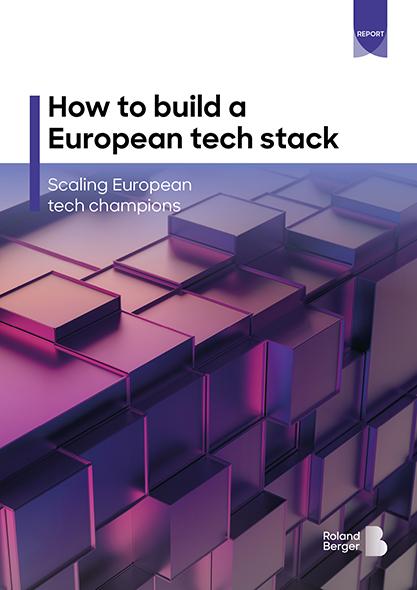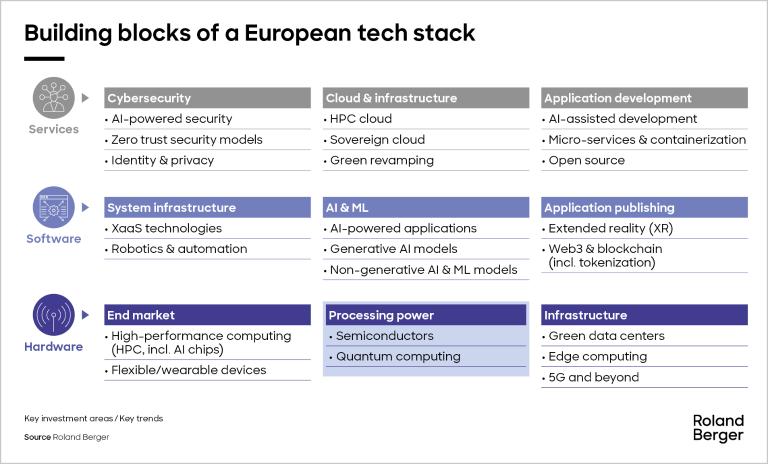After a stagnant 2023, the tide is turning, according to Roland Berger’s European Private Equity Outlook 2024, which highlights the sector’s key trends.


Scaling European tech champions
How to build a European tech stack
Europe needs a robust technology ecosystem in order to ensure its long-term technological sovereignty and competitiveness. This requires a home-grown "tech stack" – a critical mass of large-scale European players in the high-tech space – without which it stands at risk of its talent relocating abroad and driving the leadership of other regions. But despite a large domestic market and extensive talent pool, European players struggle to transform themselves into global champions. We look at the levers for ensuring a smooth scale-up process for companies and the key building blocks for a future European tech stack.

"Europe has demonstrated time and again its capacity to create global leaders in sectors such as aerospace, luxury and healthcare. In the tech sector, however, scaling beyond regional success has been a persistent challenge."
Where are Europe's champions?
Several recent EU reports have looked into Europe's widely acknowledged failure to build a home-grown tech stack, from the European Policy Analysis Group's EU Innovation Policy – How to Escape the Middle Technology Trap to Mario Draghi's The future of European competitiveness. European players can access a vast market and ample talent pool – indeed, Europe is home to 32 of the top 100 universities in the world. But they appear to hit a glass ceiling at a certain point in their expansion phase, often facing a financing gap sometimes referred to as the "second valley of death". At the same time, despite a consumer base of more than 450 million people, they suffer from the fragmentation of the European market along cultural, economic and regulatory dimensions. The result? Many potential future champions simply leapfrog the European market and move to more attractive pastures, in particular the United States.
A rich ecosystem
Despite these challenges, the European tech sector remains highly attractive for both entrepreneurs and investors. It is currently home to almost 3,900 growth-stage tech companies, some of which could become tomorrow's global leaders. The continent's ability to produce and attract top talent, combined with its leadership in key areas of innovation such as AI (artificial intelligence), makes it even more competitive. While it has so far failed to produce a tech titan on the scale of its American or Chinese counterparts, Europe has 59 tech firms that have surpassed EUR 100 million in revenues in the decade and a half since their foundation, of which, even more impressively, more than a dozen have passed the EUR 300 million mark.
Europe's tech landscape has noticeable strengths in specific countries, forming powerful regional tech hubs. Thus, the United Kingdom dominates application publishing and cybersecurity, the Netherlands excels in application publishing, Finland leads in gaming and France also does well in gaming and software. Looking at the dozens of tech companies that have been able to scale up in Europe, three broad success factors can be identified: a controlled ramp-up, an agile culture, and "ecosystem nesting", or successfully positioning the company within a network of solid partnerships.
From start-up to scale-up – winning strategies for companies
For tech companies to grow smoothly from start-ups to scale-ups, they must master the challenges of the European market. We identify three winning strategies for doing so. The first is a buy-and-build strategy, in which the firm focuses on acquiring multiple smaller companies within Europe that offer complementary capabilities or market access. This enables them to snowball, diversifying their product offering and establishing market leadership across various European countries. The second strategy is to leapfrog into global markets: in this approach, the player rapidly expands into markets such as the United States, China or Southeast Asia, often bypassing growth in its home region. This approach can help it achieve rapid revenue growth and brand recognition, establishing a strong international presence and positioning itself as a global leader. A third option is to stand on the shoulders of giants, so to speak: The company forms mutually beneficial strategic partnerships with global industry leaders and so gains access to their infrastructure, market presence and expertise. This allows them to scale up quickly and penetrate competitive and otherwise potentially inaccessible markets.
"In order to scale up in a highly competitive tech environment, choosing the right expansion strategy is critical. Whether it's leapfrogging into the United States, standing on the shoulders of tech giants, or industrializing external growth to support pan-European expansion."
Building a European tech stack
To ensure Europe's competitiveness and technological sovereignty, the private and public sectors must be able to rely on European players with robust capabilities in each key building block of the tech stack. Two of these building blocks have a systemic impact on productivity across industries: the first is AI and ML (machine learning), the second, processing power, specifically semiconductors and quantum computing.
Semiconductors are a critical technology, with applications ranging from smartphones and automotive systems to AI and data centers. Europe already has a solid foundation here and is home to four of the world's top 25 semiconductor companies by revenue.
Quantum computing has the potential to revolutionize industries such as cryptography and pharmaceuticals, and transform fields such as material sciences and financial modeling. Europe is currently at the forefront of quantum research, commanding around 30 percent of the global quantum market. However, its leadership in research has yet to translate into market dominance. To capitalize on this immense potential, Europe needs to invest significantly in enabling technologies, promote public-private partnerships, focus on commercializing quantum innovations and develop a comprehensive quantum ecosystem.
Register now to access the full report “How to build a European tech stack - Scaling European tech champions” and explore Europe's need for a unified tech ecosystem. Furthermore, you get regular news and updates directly in your inbox.




_tile_teaser_w425x260.jpg)






_person_144.png)



